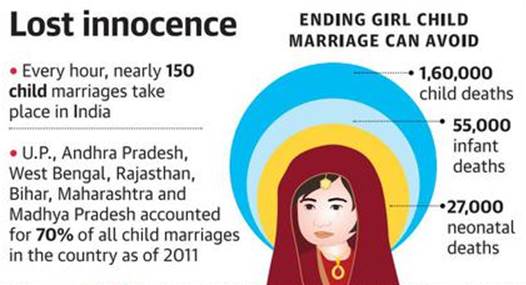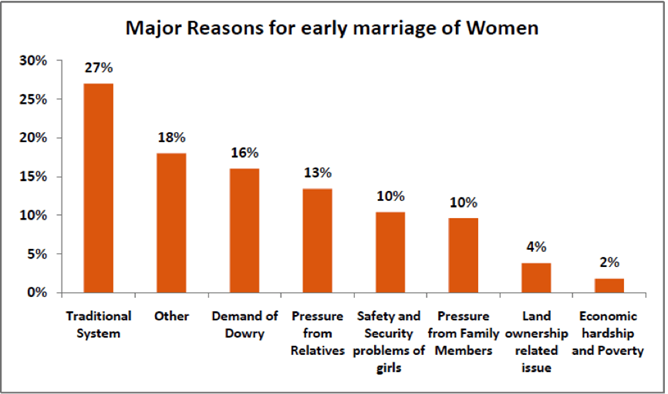Description

Copyright infringement not intended
In News
- An international steering panel by the United Nations Population Fund and United Nations International Children's Emergency Fund (UNFPA-UNICEF) Global Programme to end Child Marriage is visiting India to witness state initiatives which helped in declining the incidents of child marriages.
- They visited to learn from India’s successes in reducing the incidence of child marriage.
Details
- The panel estimates that as a result of the pandemic nearly 10 million children could become child brides globally.
- In India, child marriage reduced from 47.4% in 2005-06 to 23.3% in 2020-21, according to the National Family Health Survey-5 (NFHS 5) data.
- According to UNICEF, every year nearly 12 million girls are married before they turn 18 years of age, and it is estimated that more than 150 million additional girls will marry before 18 years by 2030. Therefore steps must be taken to end the practice.
- In the past decade, some progress has been made in South Asia, where a girl’s risk of marrying before she is 18 has from nearly 50% to below 30%, but it is not enough, and also the progress has been uneven.
Child Marriage in India
- As per Census 2011, over 12 million child marriages were reported in the country.
- Child Marriage is defined as a marriage of a girl or boy before the age of minimum legal age (18 years).
- According to the data released by National Family Health Survey-5
- In India, 8 States have a higher prevalence of child marriage than the national average; West Bengal, Bihar and Tripura top the list with more than 40% of women aged 20-24 years married below 18.
- States with a large population of tribal poor have a higher prevalence of child marriage. In Jharkhand, 32.2% of women in the age bracket 20-24 got married before 18 years.
- Infant mortality stood at 37.9%
- 8% of women in the 15-19 years age bracket are anaemic.
- Assam too has a high prevalence of child marriage (31.8% in 2019-20).
- States with high literacy levels and better health and social indices have performed much better; In Kerala, women who got married before the age of 18 years stood at 6.3% in 2019-20.
-
- The reason behind Child Marriage
- It is a widely practised social custom.
- Poverty and Illiteracy of a Child's parents.
- Social and Economic Condition of the family including the Cultural values of the family and the Surrounding Society.
- Lack of awareness about the harmful effects Lack of easy access to Schooling.
- Political Patronage: Due to Social acceptance politicians find it difficult to oppose the practice of child marriage as it may mean losing votes and Support.
- Child marriage is also widely reported to be used to traffic girls from poor and tribal families for either the Sex trade or as cheap labour.
- It is more prevalent in rural areas.
- Rates of Child marriage are highest in the Central and Western parts of India and lower in the eastern and southern parts of India.
- Result of Child Marriage;
- It Restricts access to education and better opportunities in the future.
- It limits the freedom of decision and promotes socio-economic and gender inequality.
- It is associated with multiple health risks, limited Knowledge and access to, and use of, Contraception and reproductive health services and information.

Concern
- Child marriage violates children’s rights, and also results in more infant and maternal deaths. Children born to adolescent mothers have a greater possibility of seeing stunted growth as they have low weight at birth. According to NFHS-5, the prevalence of child stunting is 35.5% in 2019-21.
- About a quarter of 20-24-year-old women are married before the age of 18 years, despite that being the minimum age of marriage since 1978.
- The limited success of the current law raises the question of whether an increase in the minimum age would have any significant impact on reducing the incidence of child marriage
- According to NFHS-5 (2019-21), the prevalence of underage marriages remains high, with 23% of women between 20 and 24 years of age married before the age of 18. At the same time, the detection of such marriages remains low, with only 785 cases registered under the law in 2020.
- This raises the question of whether the increase in the minimum age would have any significant impact on reducing child marriages.
- Increasing the legal age for marriage for women will increase the number of marriages performed underage and render young adults without legal protection.
Steps by Government
- Indian Parliament enacted several laws including the Prohibition of Child Marriage Act, 2006 and the Protection of Children from Sexual Offences Act, 2012, to protect the human rights of Children.
- Beti Bachao Beti Padhao to address the declining Child Sex Ratio.
- PM Matru Vandana Yojana (PMMVY) Providing Cash incentives for improved health and nutrition to pregnant and nursing mothers.
- Scheme for Adolescent Girls aims at girls in the age group 11-18, to empower and improve their social status through nutrition, life skills, home skills and vocational training
- Pradhan Mantri Mahila Shakti Kendra scheme promotes community participation through the involvement of Student Volunteers for the empowerment of rural women
- National Crèche Scheme to provide daycare facilities to children of the age group of 6 months to 6 years of working women who are employed.
- Rashtriya Mahila Kosh (RMK) to provide micro-credit to poor women for various livelihood support and income-generating activities at concessional terms
- Swadhar Greh provides relief and rehabilitation to destitute women and women in distress.
- Ujjawala is a Comprehensive Scheme for the prevention of trafficking and rescue, rehabilitation, reintegration and repatriation of victims of trafficking for commercial sexual exploitation.
- Working Women Hostels for ensuring safe accommodation for women working away from their place of residence.
- One-Stop Centre (OSC) and Women Helpline (WH) are being implemented to facilitate access to an integrated range of services including medical aid, police assistance, legal aid/ case management, psychosocial counselling and temporary support services to women affected by violence.
- Emergency Response Support System set up under Nirbhaya Fund.
- Mahila Police Volunteers, to report the incidences of violence against women.
- The dowry Prohibition Act, of 1961, Penalizes Giving & taking.
- SABLA Scheme, Providing life Skills and Supplementary nutrition to out-of Schoolgirls.
- The national database on Sexual offenders includes the name, addresses, photographs and fingerprint details of those Convicted in Sexual assault Cases.
- National Policy for Women, 2016
- Addresses women's issues throughout life-Cycle, issues from education, health, economic participation, decision making, violence, Creation of an enabling environment etc.
- In 2020, the Union government has set up a task force under Ms Jaya Jaitly, it suggested increasing the age of marriage for females to 21.
- The Prohibition of Child Marriage (Amendment) Bill, 2021 seeks to increase the minimum age of marriage for females to 21 years.

Way Forward
- The issue of increasing the age of marriage for women must be supported with other measures that help delay underage marriages such as access to education and improving women’s safety.
- The practice of child marriages is largely due to the overall social customs, tradition, illiteracy, poverty, low status of women in society, and lack of awareness. These issues cannot be tackled by legislative interventions alone.
- There is a need for improved access to education, skill training and employment opportunities, safety for women and strengthening maternal health services to reduce maternal and infant mortality rates.
- Need to adopt a comprehensive approach to curb the factors closely related to child marriage, including poverty eradication, better education and public infrastructure facilities for children and raising social awareness on health, nutrition, regressive social norms and inequalities.
https://www.thehindu.com/news/national/explained-how-is-india-planning-to-end-child-marriage/article66101308.ece
https://t.me/+hJqMV1O0se03Njk9














